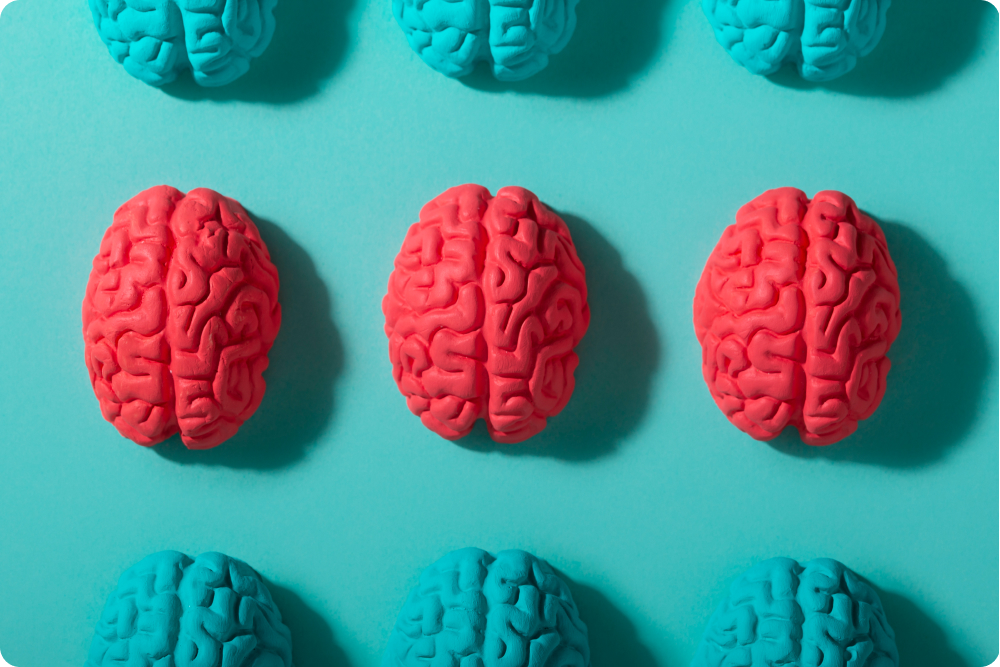Types of OCD: Looking Beyond Labels to Find Relief
“What type of OCD do I have?” This is one of the most common questions people ask when seeking to understand their symptoms. It’s a natural impulse – categorizing experiences helps make them feel more manageable and less isolating. When you can put a name to what you’re experiencing, it often provides a sense of relief and validation.
While many people search for information about “types” of OCD, this framework can sometimes be more limiting than helpful. OCD manifests in various ways; but what’s most important to understand is that effective treatment remains consistent across these different presentations.
Understanding different manifestations of OCD can be valuable – it helps one recognize their experiences and feel less alone. At the same time, becoming too focused on finding the exact right “type” or category can sometimes become a distraction from what matters most: finding effective treatment!
OCD often doesn’t fit neatly into categories. Many people experience multiple manifestations simultaneously, or their symptoms shift over time. What remains constant is the underlying mechanism of OCD, and, importantly, the approaches that help people get better.
What is OCD?
OCD is characterized by unwanted, intrusive thoughts (obsessions) that create significant distress and lead to repetitive behaviors or mental acts (compulsions) performed to reduce that distress. The underlying mechanism is a self-reinforcing cycle: when someone experiences an intrusive thought that causes anxiety, they feel compelled to do something to reduce that anxiety. While these compulsive actions might bring temporary relief, they actually strengthen the cycle by teaching the brain that these thoughts are truly dangerous and must be neutralized. This pattern repeats and intensifies over time, even though the thoughts themselves aren’t inherently harmful. While the precise symptoms – what intrusive thoughts people have and what compulsions they do – can take many forms, this core mechanism remains consistent.
Common Ways OCD Manifests
While OCD exists on a spectrum and can’t be neatly categorized, there are some ways it commonly presents. These categories are not rigid diagnoses but rather patterns that help us understand the diverse ways OCD can impact someone’s life. Many people experience symptoms that span multiple categories.
Contamination Concerns

Contamination-related OCD involves persistent fears about coming into contact with things that might be dangerous, dirty, or contaminated. These fears typically center around two main areas: physical and emotional contamination.
Physical contamination fears often focus on germs, illness, or substances that could cause harm. Someone might worry extensively about touching door handles, using public restrooms, or handling raw food. These concerns frequently extend beyond personal safety to include fears of unknowingly spreading contamination to loved ones.
Common responses include:
- Excessive cleaning or washing rituals
- Elaborate avoidance patterns
- Seeking constant reassurance about cleanliness
Emotional contamination represents a less commonly understood but equally challenging manifestation. People experiencing this form of OCD may fear being “contaminated” by negative thoughts, memories, or feelings, as if these emotional experiences could somehow taint them or spread to others.
Order and Symmetry

The need for order and symmetry in OCD extends far beyond a preference for organization. People experiencing these symptoms feel an overwhelming urge to arrange objects until they feel “just right.” This might involve aligning items perfectly, ensuring objects face specific directions, or creating precise patterns.
What distinguishes this from general perfectionism is the intense distress and “magical thinking” that often accompanies it. Many people report feeling that something terrible will happen to loved ones if items aren’t arranged perfectly. The process of getting things “just right” can consume hours of the day, significantly impacting daily functioning and relationships.
Related distress often centers around:
- A powerful sense of discomfort until items feel ” just right” (often referred to as “‘just right’ OCD”)
- Specific numbers or patterns that must be followed
- Rigid rules about how objects should be arranged
Responsibility and Checking
Responsibility OCD manifests as an overwhelming sense of duty to prevent harm and leads to extensive checking behaviors. Extending far beyond normal cautiousness, it’s driven by intense anxiety and persistent doubt about safety and responsibility.
A person might check their locked door repeatedly, not because they’re naturally security-conscious, but because they’re plagued by intrusive thoughts about break-ins and harm coming to their family. Similarly, one might review sent emails multiple times or retrace their driving route, tortured by the possibility of having inadvertently caused harm (often referred to as “hit and run OCD”).
The pattern typically involves:
- Initial action like locking a door
- Intrusive doubt about the action’s completion or effectiveness
- Repeated checking or seeking reassurance
- Temporary relief followed by renewed doubt
Intrusive Thoughts
Research shows that up to 70% of people experience unwanted, intrusive thoughts. These might include fleeting worries about whether they locked their door, momentary violent images while holding a kitchen knife, or brief inappropriate thoughts in a religious setting. For most people, these thoughts pass quickly and cause minimal distress – they’re simply part of how our minds work.
However, in OCD, intrusive thoughts take on a different character. They often focus on content that feels particularly distressing or taboo to the individual experiencing them. These thoughts can take many forms, from religious or moral concerns (scrupulosity) to unwanted thoughts about harm or sexual themes. What makes these thoughts part of OCD isn’t their content – as we’ve seen, most people have similar thoughts occasionally – but rather the intense distress they cause and how the person responds to them.
While compulsions are often visible, people with primarily intrusive thoughts often engage in mental rituals or avoidance strategies. They might repeatedly pray, mentally review situations, or avoid triggers entirely. The key distinction is that these thoughts are extremely distressing precisely because they conflict with the person’s true values and desires, and the person feels unable to dismiss them as meaningless mental noise.
Intrusive thoughts may include themes like:
- Religious or moral concerns
- Thoughts about harm
- Sexual or relationship-focused intrusive thoughts
- Existential or philosophical ruminations
Additional Manifestations
OCD can manifest in numerous other ways, each sharing the common thread of intrusive thoughts paired with efforts to neutralize anxiety. Some common presentations include:
- Real Event OCD: Persistent doubts and rumination about past events, leading to endless mental reviewing and reassurance seeking
- False Memory OCD: Intrusive doubts about the accuracy of memories, often involving extensive analysis of past situations
- Relationship OCD: Persistent doubts about feelings or relationships, characterized by:
- Constant analysis of feelings toward partner
- Comparing current relationships to past ones
- Seeking reassurance about relationship decisions
- Pure O: While technically a misnomer (as mental compulsions are present), focuses on primarily obsessional presentations
- Hit and Run OCD: Intrusive thoughts about causing accidents while driving, often leading to checking behaviors
Across all “mental compulsions” are underlying patterns of intrusive thoughts and attempts to neutralize the resulting anxiety.
Life Stage-Specific Presentations

OCD can emerge at different life stages, taking on characteristics specific to that period, latching on to what one most-deeply values. Understanding these variations can help in recognizing and addressing symptoms early.
Perinatal and postpartum OCD frequently involves intrusive thoughts about harm coming to the baby. These thoughts are particularly distressing because they directly conflict with the parent’s deep desire to protect their child. Parents might experience intense anxiety about the baby’s safety, leading to excessive checking behaviors or avoiding being alone with the infant. Despite the disturbing nature of these thoughts, they are a recognized manifestation of OCD and respond well to proper treatment.
Early-onset OCD, beginning in childhood or adolescence, often presents unique challenges as it emerges during crucial developmental periods. Young people may struggle with academic performance as rituals interfere with homework completion or classroom participation. Family dynamics frequently become intertwined with symptoms, with parents and siblings being drawn into accommodation behaviors. This early presentation often impacts social development, as young people may find it difficult to participate in age-appropriate activities or maintain friendships while managing their symptoms.
Adult-onset OCD may incorporate more complex existential themes or workplace-related concerns. Adults might experience intrusive thoughts about career decisions, relationship choices, or philosophical questions about meaning and purpose. The manifestation often reflects adult responsibilities and concerns, potentially affecting professional advancement, romantic relationships, and life decisions. Many adults find their symptoms emerging or intensifying during significant life transitions, such as starting a new job, getting married, or becoming a parent.
Regardless of when symptoms begin, the core experience of unwanted thoughts and compulsive responses remains consistent, as does the approach to treatment
Why Categories Can Be Both Helpful and Limiting
Learning about different OCD manifestations often brings significant relief. Many people describe finally feeling understood when they discover others share similar experiences. This recognition can:
- Validate experiences that may have felt isolating or shameful
- Help people articulate their symptoms to healthcare providers
- Make it easier to explain the condition to family members
- Provide a framework for understanding symptoms
At the same time, becoming too focused on exact categorization can sometimes hinder recovery. Here’s why:
Overlapping Symptoms
Most people experience symptoms that don’t fit neatly into one category. For example, someone might have both contamination fears and checking compulsions, or experience different manifestations at different times. Trying to fit complex experiences into rigid categories can lead to confusion or frustration.
Evolution of Symptoms
OCD symptoms often shift and change over time. Someone who initially experiences contamination fears might later develop checking rituals, or vice versa. Understanding that this flexibility is normal helps prevent additional anxiety when symptoms change.
The Myth of Type-Specific Treatment
While different manifestations might appear very different on the surface, the underlying mechanisms of OCD remain consistent. Evidence-based treatments like Exposure and Response Prevention (ERP) work effectively across all manifestations. Becoming too focused on finding the “right” treatment for a specific “type” can delay seeking help.
This consistency in treatment makes sense when we consider that underneath the different manifestations lies the same mechanism: intrusive thoughts causing distress, leading to compulsive attempts to reduce that distress. Whether someone experiences contamination fears, relationship doubts, or checking compulsions, the path to improvement follows similar principles.
The Path Forward
OCD can feel overwhelming, but research consistently shows that with proper treatment and commitment, significant improvement is possible. Many people who once struggled with severe symptoms now lead fulfilling lives, managing their OCD effectively through the skills learned in treatment.
The most important step is reaching out to a mental health professional who specializes in OCD treatment. They can help develop a personalized plan based on proven approaches that work across all manifestations of OCD.
Ready to take the first step? Schedule a free 15-minute consultation to discuss how evidence-based treatment can help.
Sources
1. Abramowitz, J. S., Taylor, S., & McKay, D. (2009). Obsessive-compulsive disorder. The Lancet, 374(9688), 491–499. https://doi.org/10.1016/S0140-6736(09)60240-3
2. Fairbrother, N., & Abramowitz, J. S. (2007). New parenthood as a risk factor for the development of obsessive-compulsive disorder. Journal of Reproductive and Infant Psychology, 25(3), 203–207. https://doi.org/10.1016/j.brat.2006.09.019
3. Foa, E. B., & Kozak, M. J. (1986). Emotional processing of fear: Exposure to corrective information. Psychological Bulletin, 99(1), 20–35. https://doi.org/10.1037/0033-2909.99.1.20
4. Mataix-Cols, D., & van den Heuvel, O. A. (2006). Common and distinct neural correlates of obsessive-compulsive and related disorders. Psychiatric Clinics of North America, 29(2), 391–410. https://doi.org/10.1016/j.psc.2006.02.006
5. Rachman, S. (2007). Unwanted intrusive images in obsessive-compulsive disorders. Journal of Behavior Therapy and Experimental Psychiatry, 38(4), 402–410. https://doi.org/10.1016/j.jbtep.2007.10.008
6. Salkovskis, P. M., & Harrison, J. (1984). Abnormal and normal obsessions: A replication. Behaviour Research and Therapy, 22(5), 549–552. https://doi.org/10.1016/0005-7967(84)90057-3
7. Stewart, S. E., Geller, D. A., & Jenike, M. (2004). Long-term outcome of pediatric obsessive-compulsive disorder: A meta-analysis and qualitative review of the literature. Acta Psychiatrica Scandinavica, 110(1), 4–13. https://doi.org/10.1111/j.1600-0447.2004.00302.x
8. Summerfeldt, L. J. (2004). Understanding and treating incompleteness in obsessive-compulsive disorder. Journal of Clinical Psychology, 60(11), 1155–1168. https://doi.org/10.1002/jclp.20080
9. Tolin, D. F., Worhunsky, P., & Maltby, N. (2004). Sympathetic magic in contamination-related obsessive-compulsive disorder. Behaviour Research and Therapy, 42(8), 857–870. https://doi.org/10.1016/j.jbtep.2004.04.009
10. Van Ameringen, M., Patterson, B., & Simpson, W. (2014). DSM-5 obsessive-compulsive and related disorders: Clinical implications of new criteria. Depression and Anxiety, 31(6), 487–493. https://doi.org/10.1002/da.22259
